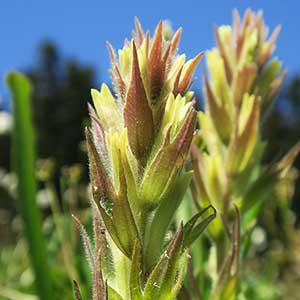Castilleja cryptantha
Castilleja foliolosa
Mt. Rainier or obscure paintbrush, obscure Indian paintbrush, obscure paintbrush
felt paintbrush, Texas Indian paintbrush, Texas paintbrush, woolly Indian paintbrush, woolly paintbrush
few to several, erect or ascending, unbranched, hairs spreading, long, soft, eglandular, mixed with short stipitate-glandular ones.
many, ascending, white or grayish due to hairs branched, much-branched proximally, unbranched to sometimes branched on distal 1/2, also usually with short axillary branches, base often shrubby and with marcescent leaves of previous year, hairs dense, appressed to spreading, medium length, soft, much-branched, eglandular, white-woolly, obscuring surface.
green, often with brown or purple veins, narrowly to broadly lanceolate, 1.5–4 cm, not fleshy, margins plane, ± involute, 0–3-lobed, apex acute to acuminate;
lobes spreading-ascending, narrowly lanceolate, apex acute to ± obtuse.
whitish or grayish, linear to narrowly lanceolate or narrowly oblong, 0.9–5 cm, not fleshy, margins plane, involute, 0–3-lobed, apex obtuse to rounded;
lobes divergent, spreading, linear, apex acuminate to acute.
(2.5–)3–6 × 1–2 cm; green to dull brown or dull reddish purple throughout, or proximally green to dull brown or dull reddish purple, distally yellow on apices, broadly lanceolate to ovate, (0–)3-lobed;
lobes ascending, narrowly lanceolate, long or short, arising near mid length, apex acute or acuminate.
2.5–20 × 1.5–3 cm;
bracts proximally green to dull pale purplish, distally red, scarlet, rose, yellow, orange, or cream, sometimes pink or white, lanceolate to oblanceolate, (0–)3–5-lobed;
lobes spreading, or distal ones erect, often oblanceolate, if 5-lobed, distal lobes usually very shallow, long or distal short, proximal bracts arising below mid length, distal ones arising near apex, apex rounded to truncate.
straight, 14–16 mm;
tube 11–14 mm;
whole corolla included within calyx;
beak adaxially pale yellow, 1–2 mm;
abaxial lip deep green, slightly inflated, 4–5 mm, 67% as long as beak;
teeth ascending, pale, 1.5–2 mm.
straight or slightly curved, 16–27 mm;
tube (8–)10–12(–14) mm;
beak exserted or partially so, adaxially green, (7–)8.5–14 mm;
abaxial lip deep green, reduced, 1–3 mm, 20–33% as long as beak;
teeth incurved, reduced, green, 0.5 mm.
proximally green or pale with green veins, lobes yellow, sometimes becoming deep red with age, 12–15 mm;
abaxial and adaxial clefts 3–7 mm, 25–50% of calyx length, deeper than laterals, lateral 1–3(–4) mm, 8–20% of calyx length;
lobes triangular, adaxial segments longer than abaxials, apex acute or obtuse.
proximally green, apices colored as bracts, 14–20(–22) mm;
abaxial and adaxial clefts 3.5–7(–9) mm, 33–40% of calyx length, deeper than laterals, lateral 0(–1) mm, 0(–7)% of calyx length;
lobes broadly triangular, apex of lobes and segments broadly rounded to truncate, segments, if present, obtuse.
= 24.
= 24.
Castilleja cryptantha
Castilleja foliolosa
Castilleja cryptantha is endemic to the vicinity of Mt. Rainier in the Cascade Range, with most populations found within Mt. Rainier National Park. Unlike most species of Castilleja, it is apparently self-pollinating (W. J. Duffield 1972); the small flowers are entirely enclosed within the yellowish calyces, which tend to grow deep reddish as they age. The purplish brown bracts are also unusual in the genus.
(Discussion copyrighted by Flora of North America; reprinted with permission.)
Castilleja foliolosa inhabits chaparral from northern California southward to northern Baja California, west of the Sierra Nevada crest. The inflorescence is usually red or red-orange but can vary to white, yellow, pink, or purple. It is present on Santa Catalina Island in the southern Channel Islands, Los Angeles County, but is replaced in the northern Channel Islands by C. hololeuca, a related shrubby species. Castilleja foliolosa hybridizes with C. martini var. martini in San Diego County.
(Discussion copyrighted by Flora of North America; reprinted with permission.)


